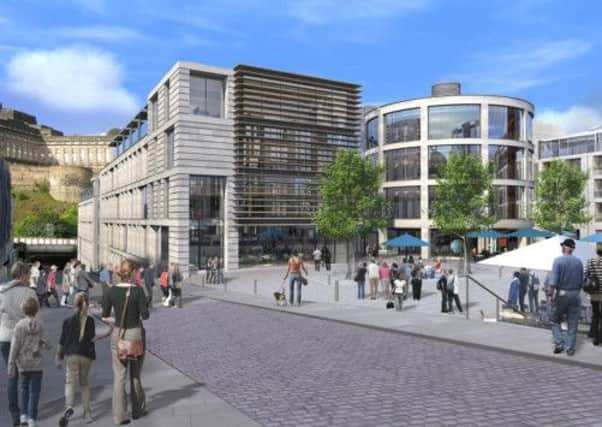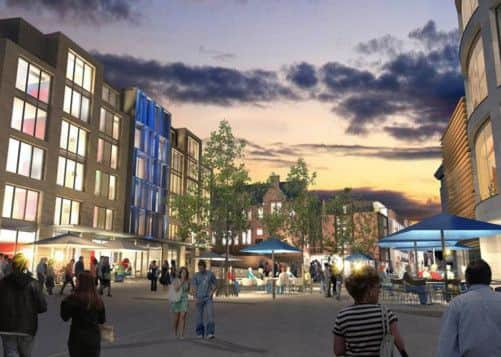Caltongate developers nearly ready to begin works


Artisan, a South African consortium behind the long-delated Caltongate scheme in the capital, has pledged to be on site by the spring if it can winning planning permission by Christmas.
New computer-generated images show how the site, next to Edinburgh City Council’s headquarters in the Old Town, would look if the local authority backs the proposals.
Advertisement
Hide AdDramatic new views would be created looking down New Street towards Calton Hill and from Calton Road to the Royal Mile under the much-delayed plans for the site, described by Artisan as “one of the most challenging city centre developments anywhere in the UK.”


But the height of buildings has been reduced and a key view from Jeffrey Street to Calton Hill will be protected under the new blueprints.
Final plans have just been lodged with the council almost two years after a rescue deal for the development was confirmed - and four years after the collapse of a previous scheme, which triggered an international investigation into Edinburgh’s World Heritage Status from Unesco.
Artisan’s scheme is significantly scaled back from one which councillors backed several years ago in the face of opposition from heritage groups and local activists. The number of jobs expected to be created has also dropped from 2000 to 1750.
The five-star hotel and conference centre that was meant to be the lynchpin of the previous scheme - approved by the council in 2008 - has been ditched.
Although Artisan had originally intended to retain the five-star hotel, with a main address on the Royal Mile, the combination of the economic downturn and a protracted battle with campaigners is thought to have put the consortium off.
Advertisement
Hide AdA listed former school building that was due to make way for hotel and conference centre is to be retained, but only the facade of a historic homeless hostel will be saved. Several office blocks will be built around a new public square.
However the new plans could still meet opposition as the £150 million scheme - roughly half the value of the original plans - will still involve the creation of three separate hotels, 185 homes and 28 retail units.
Advertisement
Hide AdThe city council has helped Artisan draw up its new plans after agreeing to sell on various sites which were due to be part of the previous development, pursued for years by London-based firm Mountgrange before the firm plunged into administration, leaving a £70 million trail of debts.
Artisan, which has offices in the Isle of Man, is described as an “international development consortium”.
Managing director Lukas Nakos said: “This is a long overdue opportunity to revitalise a strategic city centre location between Waverley Station and the Scottish Parliament – whilst being part of the very fabric of the historic heart of the city.
“The location is the missing piece of the jigsaw which will see the rejuvenation of the Old Town as a vibrant commercial and social quarter of international appeal.
“This planning application marks a significant milestone in the evolution of one of the most challenging city centre developments anywhere in the UK.
“We now have the opportunity to create, in the very heart of Edinburgh, one of Europe’s most exciting and vibrant mixed-use communities which will set an international benchmark for sensitive and innovative development.”
Advertisement
Hide AdThe previous Caltongate scheme had been backed by Historic Scotland and the Scottish Government, but was opposed by other groups like Edinburgh World Heritage and the Cockburn Association.
After the government refused to call in the application, a lobbying campaign targeting Unesco sparked a full-scale investigation, which led to it making recommendations over the scale and height of the development, which Artisan have largely adopted.
Advertisement
Hide AdMr Nakos added: “During the last 18 months, we have listened to a huge variety of views and opinions on the development of the site, and heard impassioned arguments relating to its unique importance, setting, heritage and community.
“Our planning application reflects this varied and dynamic consultation process and we feel we now have a proposal which balances ambitious and flexible commercial priorities with a genuine understanding of the area’s community and civic context.”
Caltongate history
THE site of the Caltongate development was home to the capital’s first gasworks in the 19th century.
Built in the early 1800s, the gasworks began production in 1817, providing fuel for the street lamps in Princes Street and the city’s factories during the industrial revolution. It was founded when the fuel was a new discovery and, at its height, employed about 200 people.
The gasworks had moved to Granton by the early 20th century, and by 1930 the Caltongate site had become home to a huge bus depot.
It survived until the early 1990s when it was put up for sale by the Scottish Transport Group. The building was partly taken over by the arts group Out of the Blue, which ran the popular Bongo Club nightspot there for years.
Advertisement
Hide AdVarious proposals have come and gone. Two years before Mountgrange unveiled its plans, a scheme given approval by the city council was shelved.
Mountgrange snapped up the site from Dutch group Sofam, which had joined forces with the Cuckfield Group and secured planning permission for offices, flats, an arts complex, cafes, bars and restaurants. The developer was controversially given permission to knock down the bus depot building before plans for its development were approved.
The move meant Out of the Blue was forced to find a new home, in a former drill hall in Leith, while the Bongo Club relocated to Holyrood Road. Demolition work on the site began in September 2006.